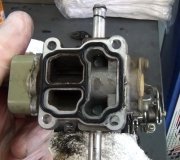I have 1994 toyota 4runner 2WD, V6, Auto transmission. I replaced the blown head gaskets on the engine. I double checked timing belt installations position and the distributer installation marks according to the servic manual. The truck starts and runs very strong. Except it idles very high at 1800 rpm and unable to check timing. Currently the distributor is rotated right in the middle of the adjustable range and the throttle is absolutely closed and can't close any more.
What could be causing the engine to run fast?
Is it possible that I have a vaccum leakage into intake manifold? If so what are the possible/common sources?
Would a bad PVC value cause a significant vaccum leakage?
Saturday, August 22nd, 2009 AT 11:28 PM


